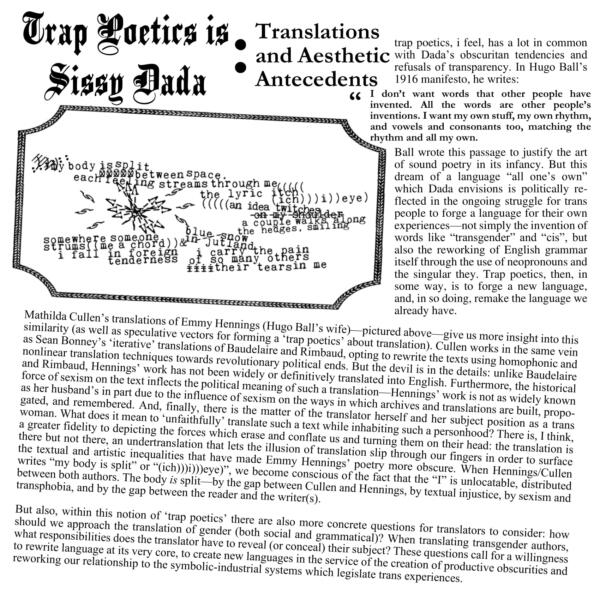“Trap Poetics” [Part 1] [Part 2] [Part 3]

Accessibility Text
This page consists of a more linear text. The text is tilted in various ways in order to appear crooked.
Trap Poetics is sissy Dada: Translations and Aesthetic Antecedents
There is an image of a poem-translation by Mathilda Cullen with a fancy border around it. This poem is very visual and has overlapping text and non-linguistic symbols, such as arrows, cross-outs, and punctuation. The text of the poem reads as follows:
“my body is split / between space. / each feeling streams through me / the lyric itch / ich, i, eye, / an idea twitches / on my shoulder / a couple walks along / the hedges, smiling / blue snow / in jutland / somewhere someone / strums (me a chord) & / i fall in foreign / tenderness / i carry the pain / of so many others / i i i i their tearsin me”
Trap poetics, I feel, has a lot in common with Dada’s obscuritan tendencies and refusals of transparency. In Hugo Ball’s 1916 manifesto, he writes:
“I don’t want words that other people have invented. All the words are other people’s inventions. I want my own stuff, my own rhythm, and vowels and consonants too, matching the rhythm and all my own.”
Ball wrote this passage to justify the art of sound poetry in its infancy. But this dream of a language “all one’s own” which Dada envisions is politically reflected in the ongoing struggle for trans people to forge a language for their own experiences—not simply the invention of words like “transgender” and “cis”, but also the reworking of grammar through the use of neopronouns and the singular they. Trap poetics, then, in some ways is to forge a new langrage, and, in so doing, remake the language we already have.
Mathilda Cullen’s translations of Emmy Hennings (Hugo Ball’s wife)—pictured—give us more insight into this similarity (as well as speculative vectors for forming a ‘trap poetics’ about translation). Cullen works in the same vein as Sean Bonney’s ‘iterative’ translations of Baudelaire and Rimbaud, opting to rewrite the texts using homophonic and nonlinear translation techniques towards revolutionary political ends. But the devil is in the details: unlike Baudelaire and Rimbaud, Henning’s work ahs not been widely or definitively translated into English. Furthermore, the historical force of sexism on the texts inflects the political meaning of such a translation—Hennings’ work is not as widely known as her husband’s in part due to the influence of sexism on the ways in which archives and translations are built, propagated, and remembered. And, finally, there is the matter of the translator herself and her subject position as a trans woman. What does it mean to ‘unfaithfully’ translate such a text while inhabiting such a personhood? There is, I think, a greater fidelity to depicting the forces which erase and conflate us and turning them on their head: the translation is there but not there, an undertranslation that lets the illusion of translation slip through our fingersin order to surface the textual and artistic inequalities that have made Emmy Henning’s poetry more obscure. When Hennings/Cullen writes “my body is split” or “ich, i, eye”, we become conscious of the fact that the “I” is unlocatable, distributed between both authors. The body is split—by the gap between Cullen and Hennings, by textual injustice, by sexism and transphobia, and by the gap between the reader and the writer(s).
But also, within this notion of ‘trap poetics’ there are also more concrete questions for translators to consider: how should we approach the translation of gender (both social and grammatical)? When translating transgender authors, what responsibilities does the translator have to reveal (or conceal) their subject? These questions call for a willingness to rewrite language at its very core, to create new languages in the service of the creation of productive obscurities and reworking our relationship to the symbolic-industrial systems which legislate trans experience.